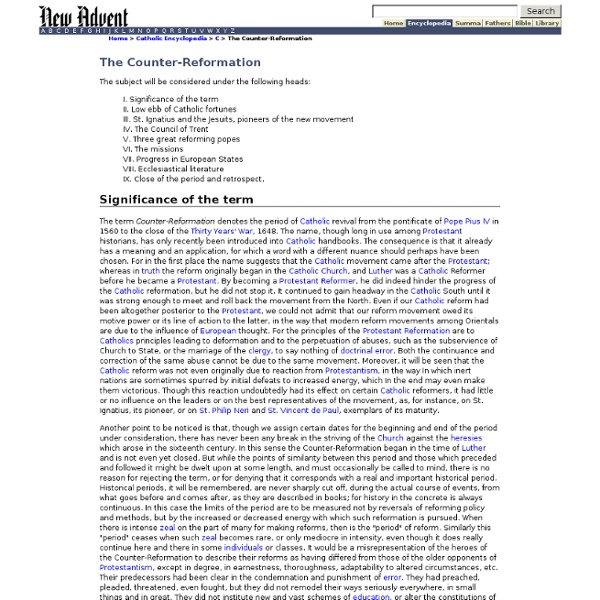The Counter-Reformation

The Counter Reformation
With strength and power the Religious Reformation swept across Europe. Dynamic men, fearlessly opposed the strong grip of Roman Catholic Power upon the lives and conscience of the people. To the casual observer in the mid 1500's, it must have seemed as though Roman Catholicism would succumb to Protestantism. However that did not happen. The Roman Catholic Church staged a remarkable come back called the Counter-Reformation, by which they not only regained much that had been lost, and greatly suppressed the reformation, but also laid the foundation for the conquest of the world which we now see in action. A conquest described by Catholic Writer and eminent theologian, Malachi Martin in "Keys to this Blood" where he "reveals Pope John Paul's own blueprint for a genuinely geopolitical structure: a one-world government that is both viable and humanly acceptable." "From the beginning of his pontification, John Paul has been talking incessantly about the convergence of the nations. 1. 1. 2.
Counter-Reformation
A copy of the Vulgate (the Latin edition of the Catholic Bible) printed in 1590, after many of the Council's reforms had begun to take place in Catholic worship. The Counter-Reformation (also the Catholic Revival[1] or Catholic Reformation) was the period of Catholic revival beginning with the Council of Trent (1545–1563) and ending at the close of the Thirty Years' War (1648), and was initiated in response to the Protestant Reformation. The Counter-Reformation was a comprehensive effort composed of four major elements: Ecclesiastical or structural reconfigurationReligious ordersSpiritual movementsPolitical dimensions Council of Trent[edit] A session of the Council of Trent, from an engraving. Pope Paul III (1534–1549) initiated the Council of Trent (1545–1563), a commission of cardinals tasked with institutional reform, addressing contentious issues such as corrupt bishops and priests, indulgences, and other financial abuses. Religious orders[edit] Politics: The Netherlands[edit]
"Rome, the Renaissance and Counter Reformation"
EtruscansAncient Rome Medieval Rome RenaissanceBaroqueModern Rome The reaction of Pope Paul III (1534 - 1549, Alessandro Farnese) to the Protestant reform was to summon the council of Trent (1545-1563) and the Counter-Reformation. The most vividly remembered result is the Holy Inquisition which had begun in Spain and which the church extended to other countries. The objective of the Counter-Reformation was to use moral persuasion and the Holy Inquisition to minimise the effects of the (northern) reformers in an attempt to maintain unity of faith and of the Catholic church. Nevertheless the Reformist movement gained the support of many national states of northern Europe which were keen to challenge the political strength and material wealth of the Roman church. The church employed the newly founded Jesuit order as a tool to stem heresy through moral persuasion and teaching as well as a missionary vehicle aimed at Christianisation of the New World. Food for thought…..
Related:
Related:



